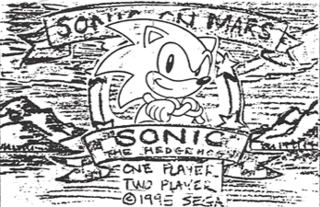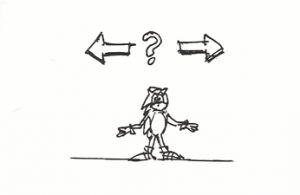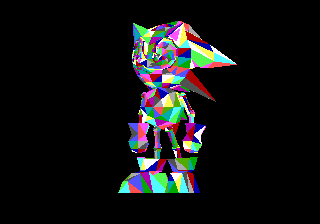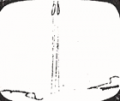Sonic Mars
From Sonic Retro
(Redirected from Untitled STI Sonic game)
| Sonic Mars |
|---|
| System(s): Sega 32X |
| Developer: Sega Technical Institute |
| Development timeframe: 1994[1]-1995[2] |
| Planned release date: 1994-11, 1995-06 |
| Genre: Action |
Sonic Mars is an unreleased Sega 32X action-platform game developed by Sega Technical Institute and scheduled to be published as a launch game for the system.[1] Intended to be the first 3D entry in the Sonic the Hedgehog series, it was estimated to ship on a 16MB cartridge with two-player simultaneous gameplay. However, the commercial failure of the 32X and a myriad of development issues resulted in the game eventually being moved to the Sega Saturn - where it would evolve into the equally-unreleased Sonic X-treme.
Contents
Story
| “ | "While Sonic is away checking on a security alarm in a remote part of the Great Forest, his pals (Sally, Bunnie, Tails and Knuckles) have discovered a strange message from within one of Robotnik's super computers.
|
„ |
While Sonic Mars's story changed numerous times through development, the plot retained a number of recurring themes. Aside from the introduction of Tiara Boobowski and her father King Cyberooski (the leader of Micro Mobius), Robotnik's SWATbots were set to make a return as enemies. Additionally, the series staple of Animal-powdered Badniks has been replaced with the concept of Mips, the inhabitants of Micro Mobius who are being captured and used to power the game's badniks.
The game's opening cutscene was storyboarded out in Michael Kosaka's initial game script, in which the Freedom Fighters intercept a distress call from the virtual reality world of Micro Mobius. Soon, Sonic returns from a patrol to find Knothole Village destroyed by Robotnik's Raiderbots, and his friends captured. He quickly makes his way to Robotnik's lair, where he accidentally gets teleported into Micro Mobius, beginning the game.
Two types of cutscenes were planned. The first type would be triggered by various events, like collecting Item Boxes. These types of cutscenes would appear during gameplay, displaying a character's portrait on the top of the screen accompanied by on-screen dialogue. Depending on the situation, this dialogue could either provide encouragement or discouragement to players, and each character would feature their own dialog. Sonic begins stages with a shout of encouragement, and shares his worry when he has only one Ring remaining. Tails will cheer on the player after collecting a Super Ring power-up, as does Knuckles when an Invincibility is collected. Sally comments when acquiring a 1-Up, Tiara congratulates the player when reaching 50,000 points, and Bunnie provides a warning when the timer reaches 9:00. Non-playable characters also provide dialogue throughout the story, such as King Cyberooski complimenting players on collecting 100 Rings, and SWATbots going on alert when approaching bosses. Robotnik also chimes in, taunting Sonic upon every death. In the penultimate cutscene, Sonic has to make a choice between Sally and Tiara, with the character he runs after being played in the final stage.
The second type of cutscene would be triggered when a level is completed, incorporating fully-animated scenes powered by the 32X. These videos would be entirely rendered in 3D, containing brief vignettes of the story and showcasing the various character's personalities. Sonic would wag his finger, Tails would hold his fist in the air, Knuckles would pose in a martial arts stance, Bunnie would perform a flying side kick, Sally rests her hand on her hip, and Tiara would emit sparks from her fingertips. An additional cutscene was planned to feature Antoine D' Coolette comically slipping while trying to high-five Sonic.
According to Michael Kosaka's game script, there were two endings planned for Sonic Mars. The bad ending is shown when all seven emeralds are not collected. There is no ending cutscene, and the game simply displays the credits followed by a "The End" screen with Sonic and a random partner. If all seven emeralds are collected, a special ending cutscene is played, showing the cast back together again. They commenting on Robotnik's downfall while rebuilding Knothole Village in a safer location, and are thanked for their hard work by King Cyberooski. The group begins tossing Sonic into the air in celebration as he gives a thumbs-up, followed by the credits scroll, ultimately concluding on a "The End" screen with Sonic and Tails.
Gameplay
Sonic Mars would have featured action-platform gameplay with six playable Zones (each separated into three Acts), two bonus stages, and an emphasis on cooperative gameplay. Zones were reportedly made up of "2-4 floating cubes suspended in mid-air", with unlockable characters hidden in each area. Each Act concludes with a Signpost. Like Sonic the Hedgehog 3, the sign can be juggled in the air, and there is a chance an Item Box will appear. All of the Rings collected by Sonic are then shown splashing out of a tube.
Had it been released, the game would have featured a unique easter egg. Upon starting the game, pressing any button besides ![]() will play an audio clip of either Sonic, Tails, Sally, or Robotnik saying "SEGA!". Yet another cheat was to be hidden on the title screen, where a button sequence would activate a cheat menu featuring a level select and sound test.
will play an audio clip of either Sonic, Tails, Sally, or Robotnik saying "SEGA!". Yet another cheat was to be hidden on the title screen, where a button sequence would activate a cheat menu featuring a level select and sound test.
Playable characters
Sonic Mars planned to include six playable characters, all boasting unique on-screen dialog. Starting the game with Sonic the Hedgehog, players can encounter new characters during gameplay. Rescuing these characters by bringing them to the end of the level unlocks their future use. Each character is able to perform a special ability by double-tapping any button, and players can switch between characters on the fly by pressing ![]() .
.

|
Sonic the Hedgehog |
|---|---|
| Sonic is the hero of the game, who has the special ability to activate a shield which protects from damage for a split second. | |
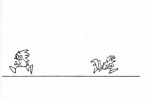
|
Miles "Tails" Prower |
|
Zone: King's Gambit | |
| Tails is Sonic's young sidekick, who has the special ability to fly, swim, and carry Sonic using his tails. When rescued, he and Sonic high-five each other. | |

|
Knuckles the Echidna |
|
Zone: Ice Breaker | |
| Knuckles is Sonic's friendly rival, who has the special ability to glide and climb walls. When rescued, Knuckles and Sonic spin dash into each other, with the impact giving off fireworks. | |
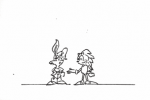
|
Bunnie Rabbot |
|
Zone: Fat Tuesday | |
| Bunnie is a partially-roboticized friend of Sonic, who is able to vertically extend her grappling arm to both reach new places and pull items and characters towards her. She does not have a double-tap special ability. When rescued, Sonic offers Bunnie a high-five, only for her to smack him silly. | |

|
Princess Sally Acorn |
|
Zone: Dream Wave | |
| Sally is another close friend of Sonic, who has the special ability to summon a temporary hoverboard which can fly, surf, and carry Sonic. She is also able to use NICOLE to reprogram locked doors, traps, and computer systems. When rescued, Sally kisses Sonic, but folds her arms and turns away when it is not reciprocated. | |
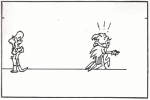
|
Tiara Boobowski |
|
Zone: Cryptic Grotto | |
| Tiara is a princess with electrical powers, who has the special ability to transform into particles of electricity to navigate the level and carry Sonic. When rescued, Tiara hugs Sonic, only for Sally to walk in and express her disappointment, with both women then walking offscreen. |
Items
| Super Ring | |
|---|---|
| Awards Sonic with extra Rings. | |
| Invincibility | |
| Grants Sonic temporary invincibility. | |
| Power Sneakers | |
| Increases Sonic's movement speed. | |
| 1-Up | |
| Awards Sonic with an extra life. | |
| Magnetic Shield | |
| Allows Sonic to take an extra hit and attract nearby Rings, acting like its Sonic the Hedgehog 3 counterpart. | |
| Bubble Shield | |
| Allows Sonic to take an extra hit and breath underwater, acting like its Sonic the Hedgehog 3 counterpart. | |
| Electron Box | |
| Allows Sonic to walk over electrified conduits. | |
| Eggman Mark | |
| Damages Sonic. | |
| SWATbot Repel | |
| Repels Rings for 15 seconds. | |
| Continue | |
| Awards an extra Continue. Acquired by collecting 255 Rings. |
Zones

|
King's Gambit |
|---|---|
|
Boss: Orbotnik Source: Michael Kosaka script | |
| King's Gambit would center around a chessboard theme. In this level you rescue Tails. The background would have a bright blue sky filled with puffy clouds and a bright sun. In the distance hills could be seen. The theme of the boss area is a roulette wheel, with the boss sitting in the middle of the area. | |
| Ice Breaker | |
|
Boss: Frozebotnik Source: Michael Kosaka script | |
| The level would have a snow theme, similar to IceCap Zone in Sonic 3 The background would have snow covered mountains in the distance and a body of water filled with glaciers and broken pieces of ice. The northern lights would cycle different colors in the sky. The boss area would have two intersecting snow-covered ridgelines and four small cliff areas. The background shows snowcovered mountains and a clear blue sky. | |

|
Fat Tuesday |
|
Boss: Beignetnik Source: Michael Kosaka script | |
| Fat Tuesday would take place in New Orleans during Mardis Gras. Neon lights, lit office buildings, car headlights can be seen and tail lights can be seen on the freeway below. A red-orange sunset can be seen in the background. The boss arena is set in the city during the parade. Sonic can jump onto the second floor balconies and rooftops. | |
| Dream Wave | |
|
Boss: Trouble Cleff Trap Source: Michael Kosaka script | |
| Dream Wave takes place in the cloudtops. You can see the night skies and stars, moons and galaxies are visible. The boss area's background is a subtle undulating blue/black color-cycling background which rhythmically pulses to the accompanying music. | |
| Cryptic Grotto | |
|
Boss: Octocknik Source: Michael Kosaka script | |
| Cryptic Grotto is an underwater level covered with seaweed and several caverns. The boss area takes place underwater as well, with a sunken ship in the background. | |
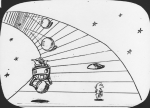
|
Core Memory |
|
Boss: Robotnik Source: Michael Kosaka script | |
| Core Memory is a level filled with electrical parts and data buses, and the game's final stage. Printed circuits can be seen. The boss area is an "Endless Loop Trap", a continuous connected loop which your character is forced to run along. There are a few speed bumps built into the road. The background is outer space with stars and moons littering the night sky.
| |
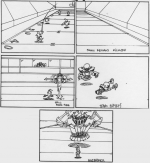
|
Unknown |
|
Boss: Unknown Source: Unknown | |
| An American football-themed Zone. Sonic is able to return a kickoff, must avoid getting showered with Robo-Ade (a parody of Gatorade), and must contend with the unique Team Player and Linebacker Badniks. | |
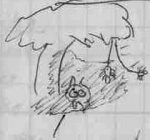
|
Shadow World |
|
Boss: Unknown Source: Don Goddard script | |
| Shadow World was infrequently mentioned, and little is known about this world other than there are swinging spiders that pop out of the shadows. Before they swing out you can see a light reflection from their eyes but occasionally these light reflections will be from normal animals. | |

|
Jungle World |
|
Boss: Unknown Source: Don Goddard script | |
| Jungle World would be a jungle-themed Zone, with three specific Acts planned out:
Act 2: Waterfall Zone begins after getting off the vine from the last level you land on another cliff. From there you need to jump from rock to rock the entire length of a waterfall being careful not to be knocked off by the steam of water. Enemies planned are more mostly harmless wildlife. Mother birds that are protecting their nests and squirrels which throw nuts. Act 3: Logjammer Zone features a colony of beavers at the bottom of the waterfall, pushing logs down the river. The logs will float offscreen so you need to jump from log to log. The water is shallow so it is possible to jump in it and collect powerups sitting in it. Sonic needs to avoid being crushed by the logs also. The only enemies planned are Beavers. They can climb on the log and bite or swat you with their tail. If Sonic is in the water with them they can't bite but will swim faster. | |

|
Bonus Zone |
| Bonus Zone is an air hockey table minigame with Sonic on one end and Robotnik on the other. Two tubes are located at the center which despense the pucks or Bonus spheres. The bonus spheres contain 1-ups, continues, points, or power-ups and are destroyed when hit, or on their own when they are on screen for several seconds. The d-pad moves the air shuttle, | |

|
Special Zone |
| Special Zone is alluded to in some concept artwork included with the script but nothing is said of it, other than you collect Chaos Emeralds here. It is probably the same as a regular level but with the Chaos Emeralds hidden somewhere. | |

|
Sonic Bowling |
| Sonic Bowling is a minigame in which Sonic would roll into a ball and move down the alley and and either knock down a row of pins, or collect a row of rings. | |
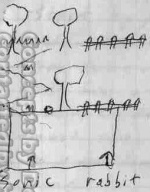
|
Rabbit Races |
| Rabbit Races features a jealous rabbit character will frequently challenge Sonic to a race. He is slower than Sonic so he relies on traps, like trip cords and catapulting platforms to beat him. When he's far enough ahead he rests and sits agains a tree mocking you. The script mentions that it would be a bonus round available for use on certain rounds. |
Enemies
Bosses

|
Orbotnik |
|---|---|
|
Zone: King's Gambit | |
| Orbotnik is sitting in a glass sphere in the center of the roulette wheel. He releases steel balls from two tubes located at the side of the screen which roll and bounce around the roulette wheel eventually stopping on a wedge. He will also randomly electrify a wedge in the roulette wheel, destroying steel balls if they happen to be on it. If Sonic Spin Dashes into him the sphere will crack, eventually crumbling after 6 hits. | |
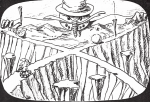
|
Frozebotnik |
|
Zone: Ice Breaker | |
| Frozebotnik stands far in the background and rolls giant snowballs down the ridgeline. He pounds the mountain at certain times which release giant icicles from the ceiling. To hit him you have to hit his carrot nose. When hit his nose shortens up to 8 times when he finally dies. | |

|
Beignetnik |
|
Zone: Fat Tuesday | |
| Beignetnik stands on the far side of the screen. He has a colorful mask and is dressed like a clown. He throws Barrels, Necklaces, and spinning Magic Wands. He also has a sneeze attack. | |

|
Trouble Cleff Trap |
|
Zone: Dream Wave | |
| Trouble Cleff Trap isn't really a boss but a dangerous stage. The bottom of the stage has no floor and musical notes float across the screen. The screen scrolls so you need to keep jumping across the notes. Occasionally sharp notes come across so those need to be avoided. | |
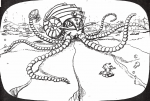
|
Octocknik |
|
Zone: Cryptic Grotto | |
| Octocknik is a powerful, armored octopus that throws seashells and starfish. He can darken the screen to near blackout with his ink for several seconds. He dies after taking 14 hits. | |

|
Robotnik |
|
Zone: Core Memory | |
| Robotnik attacks using three different vehicles:
Gatling Gun Vehicle: Robotnik flies offscreen and tries to strafe Sonic with his gatling gun. He makes 2 passes, then flies off. Hammer Vehicle: Robotnik flies off screen then tries to hit Sonic with his hammer. If he misses and hits the loop instead the ground will shake and the bowling balls will bounce and reposition horizontally. He attacks three times then flies off. |
History
Development
| “ | "Michael was studying the previous Sonic games and creating the design document for the game…I seem to remember making some 2D side-view animations of Sonic at that early stage. My first real artwork consisted of two animations demonstrating the game concept. They were flat-shaded and looked like actual games in action. I even made ring-counters that incremented when Sonic picked them up. These animations were to be used to sell the concept to the executives." | „ |
| — Designer Chris Senn[1] | ||
A Western-developed Sega Technical Institute Sonic game had been planned by the division for some time, most notably as the unreleased late 1993 Mega Drive title Sonic-16. While this project was unrelated to any later Sonic games, the idea would stick around and still be fresh in the memory of a couple of STI developers as they entered into the new year.
Envisioned by Sega of America management sometime around early 1994 as a Sonic the Hedgehog title for the upcoming 32X, the project was intended as a launch game for the system, leaving the small team scrambling to work as fast as possible by Christmas of that year.[1] The group was very much inspired to move to 3D after the release of Virtua Fighter[4], with Sonic intended to be a 3D model early in development.[5] Unfortunately, the game design during this early stage wasn't fully formed enough to determine if the 32X hardware could even run the game they were planning.[6]
The development team (sometimes identified by Roger Hector as "Sonic Team"[7]) was being lead by Michael Kosaka, who created his design proposal by studying previous titles in the Sonic franchise, and also penned the earliest known story for the game.[8] This design proposal, created on May 17, 1994, initially expected the project to be completed by June 1995. Initially, the decision was made to ground the story within the framework of the Saturday morning television series that was still airing at the time; a setting which was dropped later in development. Designer and artist Chris Senn was a core member of the team at this time[8], working as a character designer[7] and animator, as was artist and 3D modeler Ross Harris (who created the game's 3D models in Softimage 3D and later digitized them into pre-rendered sprites[9]). The group's lead programmer, Don Goddard, was brought on that September.[10][11]
The team soon realized the 32X would only be able to reasonably render a few hundred polygons at once (nowhere near what they would need for a fun game world), so Goddard created a 3D Doom-like engine which could smoothly rotate 90 degrees in any direction (including up and down), allowing for crude "loops". He says the team came up with a single concept for a "rail-style" game around this technology (likely referring to linear, Crash Bandicoot-like gameplay), but as the original intention was a free-roaming 3D game, this experiment was scrapped.[12]
Goddard later programmed a "blazingly fast scaled/rotated sprite routine" which could display thousands of sprites at once, and created a demo where Sonic runs around on a black background with about a thousand Rings bouncing around the screen. Running at 60fps, it was playable at Sega of America's Daddys and Daughters Day 1994. Shinobu Toyoda, company executive and one of the project's few supporters outside of Roger Hector[12], brought his daughter to work that day, and they both played and enjoyed the brief demo - despite Goddard admitting it to be a very basic one.[12][13]
Following the success of Goddard's demo, the development team began creating new concepts entirely out of multiple sprites, including Senn designing multiple monsters constructed out of Rings. Goddard recalls they were possibly going to design a specific zone or two populated with these Ring creatures, which would appear as either a stack of rings or a giant one, and would slink around the playfield. When hit, they would explode into smaller rings which could be collected as a unique gameplay mechanic.[12]
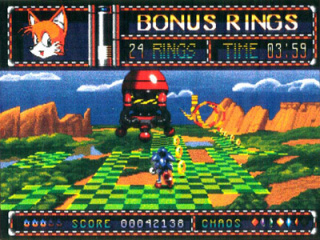
Senn would not only begin creating new characters during this time (like Tiara Boobowski, seen during the October 1994 airing of the MTV television special Rock the Rock), but also produced a number of key early test animations for the project. Produced in Deluxe Paint Animation on his Amiga 3000 computer, he created a total of three demos for the project. The first two are potential gameplay concepts, featuring Sonic running around small gamefields suspended in the sky and demonstrating how the new 3D gameplay could possibly work - and synched to the track "Stardust Speedway - Bad Future" from the album Sonic the Hedgehog Boom. The third was a bonus stage conceptualized by Michael Kosaka, in which Sonic would roll through a hollow circuit of tube attempting to collect as many Rings as possible.[5] The 3D model of Sonic created for these Amiga pitch demos was later stored in a proper 32X ROM, known as the Mars Sample Program.
Despite being in development for the 32X, Sega of America management was reportedly already considering moving the game to the company's following console (what would become the Sega Saturn). Because the team didn't have a solid answer on the choice of platform (nor any choice in the matter[14]), Senn's Amiga demos were rendered on the conservative side, with flat-shaded graphics more comparable to the 32X.[1] Senn also created a mockup of a potential isometric gameplay concept[15], featuring Sonic in a Green Hill-like environment[16], which was used to explore another means of implementing the character in three dimensions.
These early tests were used to pitch the gameplay concept to company executives Tom Kalinske, Shinobu Toyoda, Yuji Naka, and a small group of others, who said that the graphics would have a hard time competing with games like Donkey Kong Country.[1] The executives insisted on a stronger focus around classic franchise staples like loops and Rings, disregarding the team's attempts to design a new game concept specifically for a 3D environment - and nearly bringing Senn to tears during the meeting. According to Goddard, Sega's management was asking the team for a game more similar to what would be seen in the later Sonic Adventure, but years earlier by a smaller team on less powerful hardware.[12] To make matters worse, Yuji Naka himself simply shook his head, turned to Chris Senn, and said "good luck."[1] Regardless, the team was able to argue that the graphics could improve, the videos showed the early gameplay concept clearly enough[1], and further Sonic staples could always be added down the line, and the project continued without issue. Sometime during this era, the game gained its working title of Sonic Mars: a reference to the Mars codename of the 32X hardware. Later in development, this name would evolve into a sort-of premise for the game's story, at one point becoming Sonic on Mars.
| “ | "Sonic Xtreme underwent many changes and difficulties that would have tested even the most seasoned game industry veterans. Lack of experience, poor business decisions, ego, politics, over-ambition, bad timing, poor communication... these were some of the ingredients that ultimately spelled disaster for the game. Bringing Sonic into 3D for the first time was a huge challenge - not only for gameplay, but from a technology standpoint as well. This made the job of defining what the game should be more difficult, but doubly so as the technology and platforms changed. In the first year and a half the team went through three programmers, causing the game’s technology to basically restart each time. Problems like this took a toll on the budget and created more pressure for the entire team down the line." | „ |
| — Designer Chris Senn[5] | ||
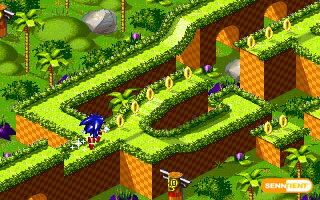
The game would miss the 32X's November 1994 release date, with this soon followed by the departure of the team's leader, Michael Kosaka, in March 1995[17], who quit Sega Technical Institute over political tensions between him and STI director Dean Lester - leaving the project with no one in charge. As a response, Senn became the game's temporary producer while management looked for another to replace him.[18] Ultimately, both Roger Hector and Dean Lester decided he should remain in this role, increasing the number of Senn's already-considerable responsibilities. However, this allowed him to take Kosaka's former gameplay design in a direction which excited him more. As Senn describes it, Kosaka's design was solidly-constructed and more in-line with traditional Sonic the Hedgehog games, but he wanted to explore the potential of approaching these established concepts in new ways.[5] Goddard took this opportunity to further rework the game's script, eventually creating an entirely new script of his own.[18] Sometimes known under the working name of Sonic 32X, this version removed all playable characters except for Sonic and introduced two new Zones.
Following this shakeup, Dean Lester also left the company around August 1995, being replaced as director by Manny Granillo.[1] At the same time, Sega Technical Institute did eventually move Mike Wallis onto the project to serve as the game's primary producer from then forward, in an attempt to save the project from slipping into further stagnation.[13] Still, this was not enough to develop the kind of game management was looking for, and the team's leader, Don Goddard, knew that they would need more hands on the project: specifically, the team would need a second programmer. Gary McTaggart, an outside programmer experienced in 3D engines recommended by STI tools developer Mark Kupper, reportedly had a great interview with the company. Despite being cheap to acquire, management dragged their feet and he was never hired.[12] Later, Goddard made his own recommendation, Midway's John Morgan (of Super Off-Road fame). He also had a very positive interview and was equally qualified for the project, but was never called back either.[12]
Following this, a third attempt to acquire a programmer was made. Dean Lester told management he'd found a software engineer from the Middle East by the name of Ofer Alon, who'd previously worked on Astro Chase 3D for the Macintosh. Alon was flown into company headquarters, and while he reportedly interviewed well, Goddard felt Alon had a superior attitude in regards to knowing what was best for the game. Additionally, he was also very expensive to hire. To the team's surprise, Alon was soon brought onboard, and began working at STI 3 weeks later.[12] This would not come without issues, as while innately talented, Alon was not the easiest to work with. According to Goddard, he would reportedly agree to gameplay designs when speaking to fellow staff, but would later ignore these requests and perform his own work - only really ever getting along with designer Chris Senn).[12]
Sometime in 1995, Goddard's team were introduced to early specifications for what would eventually become the Sega Saturn were extremely turned off, seeing it as a complicated mess to develop for. Still, they began running technical evaluations and familiarizing themselves with the hardware, with programmer Hirokazu Yasuhara suggesting development be moved to this new system outright.[5] Programmer Christina Coffin was also brought on board, described by Goddard as being a passionate developer and fun to work with, despite her tendency to work alone unwittingly coming off as paranoia to others - and resulting in her making a few enemies among the staff, particularly Ofer Alon. Senn recalls Coffin being "a wild stallion" who had difficulty taking direction, "but when unleashed did great stuff."[12] During this time, Goddard was still attempting to get Alon to cooperate or listen to any of their requests. He continued to refuse, and began locking himself inside his office for the entirety of the business day (reportedly creeping Goddard out, who worked in the office next to Alon's).[12]
As 1995 progressed, the slow and uncoordinated nature of development was taking its toll. Tensions arose between team members and Dean Lester[12], and artist Dean Ruggles was also disliked by the staff for leaving work early every day (and once walking out in the middle of a team meeting).[5][12] Alon was continuing to be uncooperative, Coffin was isolating herself from others, and some staff were working at a notably slow pace; programmer Chris Ebert reportedly spent ten months coding a 32X demo in which a camera would fly over a single line of ten polygons.[12] To compound matters, when the team put in requests to management for development resources, these requests would often go unanswered or unfulfilled for months at a time.[12]
Making things worse was the 32X itself. It was difficult to program for even before release, but now that it was on sale, it was performing notoriously poorly, and Sega of America was less than enthusiastic about releasing a flagship Sonic game for such a platform. Per Wallis, due to the relatively short development time spend working on the platform, "releasing X-treme for the 32X wasn't even a consideration".[6] As a result, management ordered the project moved off the 32X entirely around Fall of 1995[1][19], wasting months of development for the system.[20] Initially, the chosen target platform was the Sega Saturn they had previously experimented with, and development was briefly moved to the upcoming CD-based system. This would not last long, however, as Sega of America quickly pulled an about-face and changed the platform once again; this time, presenting the team with something entirely different.
Legacy
A well-known mockup image, created by Chris Senn to illustrate a potential isometric gameplay concept, was later misinterpreted as an entirely separate game. This image was commonly-thought to represent an untitled STI Sonic game.
Production credits
- Executive Producers: Dean Lester[1], Manny Granillo[1]
- Producers: Michael Kosaka[1], Mike Wallis[6]
- Team Coordinator: Michael Kosaka[1]
- Co-Lead Designer: Chris Senn[1], Michael Kosaka[1]
- Art Director: Don Goddard
- Artist: Jeremy Cantor
- 3D Modeler: Ross Harris
- Animator: Chris Senn[1]
- Technical Programmer: Ofer Alon
- Programmers: Don Goddard[11], Chris Ebert[1], Mark Kupper[12], Toshiyasu Morita
- Tools Programmers: Mark Kupper, Robert Steele
- Writers: Michael Kosaka, Christian Senn, Don Goddard
- Promotional Artwork: Jeremy Cantor[1]
- Reference: Adrian Stephens
- Source: Developer statements
Development material
Scripts
- SonicMars 32X Kosakacript.pdf
Michael Kosaka's game script
Don Goddard's game script
Concept art
Renders
Videos
External links
- Demonstration Video on YouTube.
References
- ↑ 1.00 1.01 1.02 1.03 1.04 1.05 1.06 1.07 1.08 1.09 1.10 1.11 1.12 1.13 1.14 1.15 1.16 1.17 1.18 http://www.lostlevels.org/200403/200403-xtreme.shtml (Wayback Machine: 2023-09-01 08:21)
- ↑ File:SonicMars 32X conceptart titlescreen static.png
- ↑ File:SonicMars 32X Kosakascript.pdf, page 4
- ↑ Interview: Stieg Hedlund (2006-12-15) by Sega-16
- ↑ 5.0 5.1 5.2 5.3 5.4 5.5 http://www.senntient.com:80/projects/xtreme/FAQ.html (Wayback Machine: 2011-03-17 06:48)
- ↑ 6.0 6.1 6.2 Interview: Mike Wallis (2007-06-19) by Sega-16
- ↑ 7.0 7.1 Roger Hector interview by hxc (October 2005)
- ↑ 8.0 8.1 Interview: Chris Senn (2013-09-12) by Sega Addicts
- ↑ https://forums.sonicretro.org/index.php?threads/presenting.7325/page-4#post-128889
- ↑ https://www.linkedin.com/in/don-goddard-37b15b/details/experience/
- ↑ 11.0 11.1 Interview: Don Goddard (2011-11) by Torentsu
- ↑ 12.00 12.01 12.02 12.03 12.04 12.05 12.06 12.07 12.08 12.09 12.10 12.11 12.12 12.13 12.14 12.15 Interview: Don Goddard (2008-05) by hxc
- ↑ 13.0 13.1 http://www.lostlevels.org/200403/timeline.shtml (Wayback Machine: 2023-06-21 01:35)
- ↑ Mike Wallis, Playing at the Next Level, 2015-01-07 email interview by Ken Horowitz
- ↑ http://www.senntient.com/forums/viewtopic.php?pid=8572#p8572
- ↑ File:Sxc isometric0.jpg
- ↑ https://www.linkedin.com/in/michael-kosaka-99312b1/details/experience/
- ↑ 18.0 18.1 http://www.senntient.com/forums/viewtopic.php?id=216
- ↑ Interview: Peter Morawiec (2000-12-27) by ICEknight
- ↑ Interview: Mike Wallis (2002-06) by Pachuka
| Sonic the Hedgehog games for the following systems | |
|---|---|
| |
1991 Sonic the Hedgehog | Sonic Eraser 1992 Sonic the Hedgehog 2 1993 Sonic the Hedgehog CD | Dr. Robotnik's Mean Bean Machine | Sonic Spinball 1994 Sonic the Hedgehog 3 | Sonic & Knuckles 1995 Chaotix | Sonic Classics 1996 Sonic 3D: Flickies' Island |
| Unreleased Sonic the Hedgehog games |
|---|
| Sonic's Edusoft | Sonic the Hedgehog (home computers) | Sonic the Hedgehog | Sonic the Hedgehog 2 CD | SegaSonic Bros. | Sister Sonic | Treasure Tails | Pre-May 1993 Sonic arcade games | Sonic the Hedgehog 3 Limited Edition | Sonic Sports | Sonic Ride | Sonic Saturn | Sonic X: Chaos Emerald Chaos | Sonic DS | Sonic the Hedgehog Extreme | Sonic Riders | Sonic the Hedgehog: Awakening | Sonic Central | Sonic Demo |
| Sonic X-treme incarnations |
| Sonic Mars | Sonic X-treme (Point Of View | Project Condor | SonicPC) |
